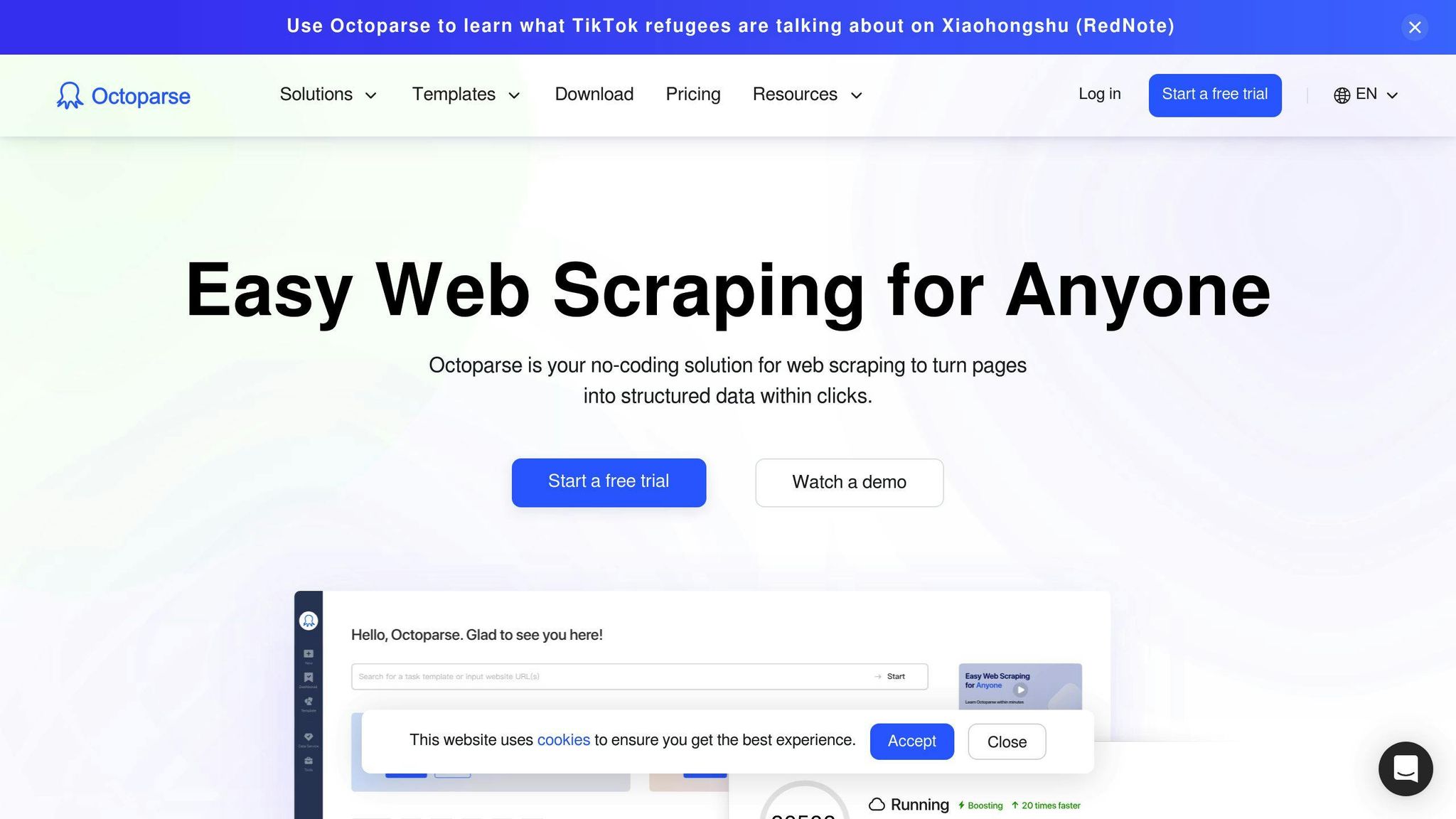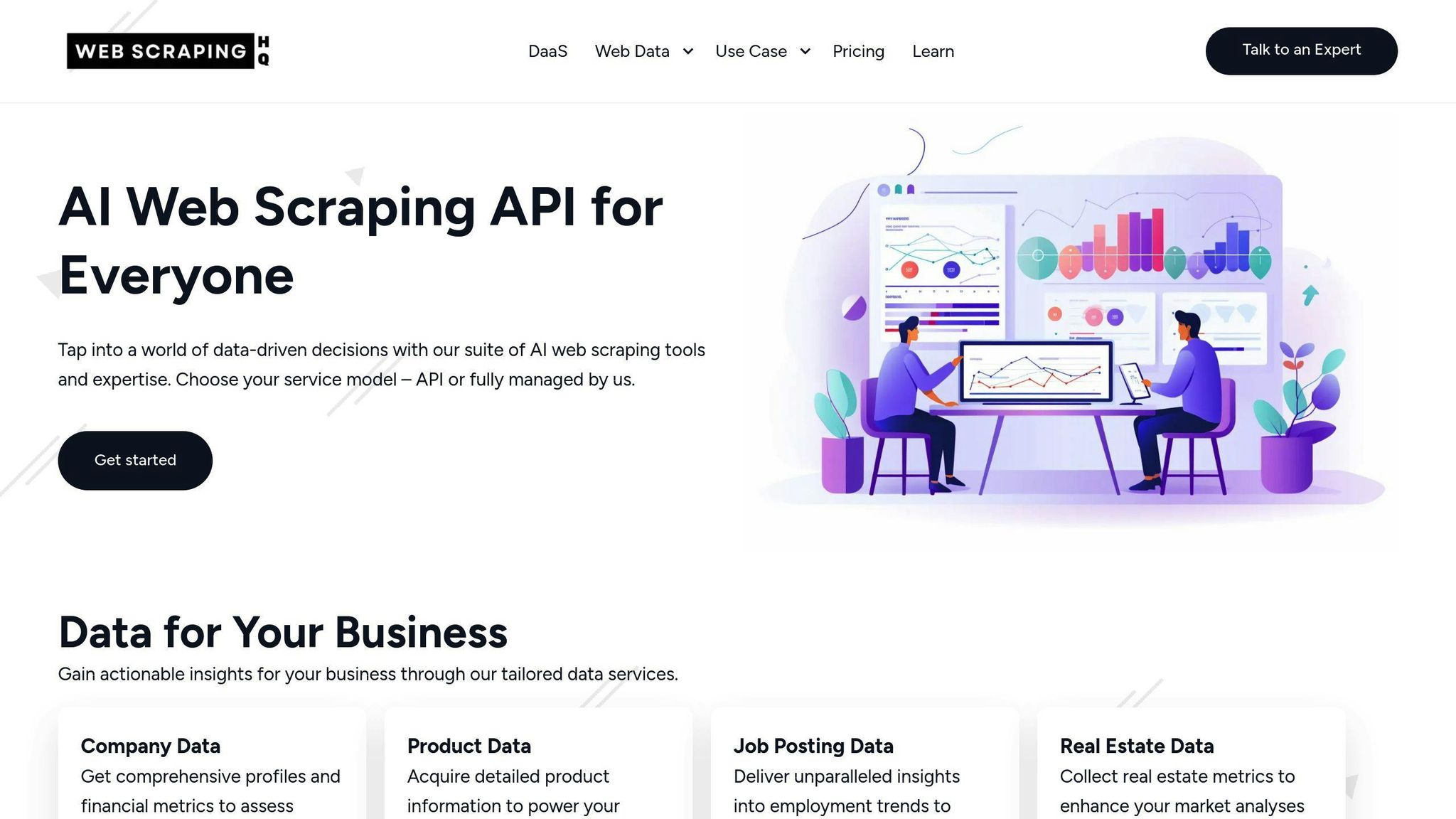
- Harsh Maur
- January 21, 2025
- 8 Mins read
- Scraping
How to Scrape Data from a Website to Excel in 2025?
Web scraping lets you extract data from websites and export it to Excel for analysis. In 2025, advancements in AI and tools make this process easier and faster. Here's a quick overview of methods:
- Manual Copy-Paste: Simple but time-consuming and error-prone.
- Web Scraping Software: Tools like Octoparse simplify scraping without coding.
- Coding with Python: Use libraries like BeautifulSoup or Selenium for custom solutions.
Key Benefits:
- Automates data collection, saving time.
- Provides real-time, accurate data.
- Scales easily for large datasets.
Quick Comparison:
| Method | Skill Level | Best For | Drawbacks |
|---|---|---|---|
| Manual Copy-Paste | Low | Small datasets | Time-intensive, errors |
| Web Scraping Software | Medium | Regular, automated tasks | Subscription costs |
| Python Coding | High | Custom, complex projects | Requires programming skill |
Always follow ethical practices, respect website policies, and comply with legal regulations. Ready to dive deeper? Let’s explore each method in detail.
How to Scrape Website Data Directly to Excel and CSV Files
Ways to Scrape Data from Websites
In 2025, there are three main ways to scrape data from websites and export it to Excel. The best method depends on your technical skills and the specific needs of your project.
Copying and Pasting Data Manually
This is the simplest option but not suited for large-scale or frequent data collection. It involves selecting the information on a webpage, copying it, and pasting it into Excel. While easy to use, it’s time-consuming and prone to errors, especially when working with big datasets.
| Aspect | Impact |
|---|---|
| Time Investment | High for large datasets |
| Technical Skill Required | Very low |
| Error Risk | High due to manual input |
| Scalability | Poor |
Using Web Scraping Software
Modern web scraping tools make data collection easier and faster without requiring programming knowledge. Tools like Octoparse offer user-friendly interfaces where you can simply click to choose the data you want to extract. These tools are especially helpful for handling dynamic content and overcoming challenges like CAPTCHA protections, making them great for regular and automated data scraping tasks.
Writing Code for Web Scraping
For those who need more control and customization, coding your scraper using Python libraries is the go-to option. Two popular libraries are:
- BeautifulSoup: Ideal for extracting data from static HTML pages, such as product titles or prices.
- Selenium: Designed to work with websites that rely heavily on JavaScript, making it perfect for dynamic pages.
When deciding which method to use, think about your specific needs. For example, if you need to regularly scrape product details from several e-commerce sites, automated tools are often the most efficient. On the other hand, Python-based solutions give you more flexibility and can be tailored to fit into existing workflows.
No matter the method, ethical data scraping is key to staying compliant and maintaining reliability. Whether you choose manual extraction, software, or coding, the goal is the same: efficiently exporting clean, structured data into Excel for analysis. Fine-tuning your approach ensures accuracy and saves time in the long run.
Tips for Effective Web Scraping in 2025
Web scraping requires precision and the right techniques to extract data reliably. Here’s how you can ensure success when pulling data from websites into Excel.
Maintaining Data Accuracy
Accurate data is the backbone of any analysis. AI-powered scrapers can adjust to website changes, helping maintain consistent quality. Use AI tools during the extraction process to validate and clean data, making it easier to analyze once exported to Excel.
| Verification Step | Purpose | Implementation |
|---|---|---|
| Real-time Validation | Catch errors immediately | Use machine learning for pattern recognition |
| Structure Verification | Keep data format consistent | Automate parsing checks |
| Quality Control | Remove duplicates and errors | Apply data-cleaning techniques |
While accuracy is key, ensuring uninterrupted access during scraping is just as important. This is where proxies and IP rotation come into play.
Using Proxies and IP Rotation
Getting blocked by websites can halt your scraping efforts. In 2025, smart proxy management is a must for uninterrupted data collection. To stay under the radar, try these strategies:
- Opt for residential proxies when handling sensitive tasks.
- Rotate IPs and add delays between requests to avoid detection.
- Test proxy uptime and speed regularly to ensure smooth operations.
Even with these measures, it’s crucial to stay within legal and ethical boundaries to ensure your scraping practices are sustainable.
Staying Legal and Ethical
Ethical web scraping means respecting both legal requirements and website-specific rules. Compliance with regulations like GDPR and local laws is non-negotiable.
| Consideration | Requirement | Impact |
|---|---|---|
| Website Policies and Load | Follow terms and limit request rates | Avoids server overloads |
| Data Privacy Laws | Adhere to GDPR and local regulations | Ensures legal compliance |
Always check the website’s robots.txt file and terms of service before scraping. This not only keeps you compliant but also helps maintain good relationships with data sources, securing long-term access to reliable information for Excel analysis.
sbb-itb-65bdb53
How to Import Scraped Data into Excel
After scraping data from a website, the next step is bringing it into Excel for analysis. Here's how you can do it.
Using Excel's Import Features
Excel offers several ways to import scraped data, with CSV and XLSX being the go-to formats in 2025.
For CSV files, you can follow these steps:
- Open Excel and go to the Data tab.
- Click on From Text/CSV in the Get & Transform Data section.
- Select your file and adjust the import settings as needed.
If you're working with more complex datasets or need ongoing updates, Power Query is a great option. It allows you to import and transform data from web pages and other sources through a user-friendly interface.
| Data Format | Recommended Import Method |
|---|---|
| CSV | Text/CSV Import |
| XLSX | Open Directly |
| JSON | Power Query |
| Web Tables | Power Query |
Once you've imported your data, it's important to prepare it for analysis by cleaning and organizing it.
Cleaning and Organizing Data
Excel provides several tools to help tidy up your data. Use functions like TRIM to remove extra spaces and PROPER to standardize text formatting.
Here are a few tips for organizing your data:
- Keep data types consistent across columns.
- Use the Remove Duplicates feature to eliminate repeated entries.
- Set up data validation rules to maintain accuracy.
- Add clear and descriptive column headers.
To keep your data updated automatically, you can configure Power Query connections to your source. This ensures your analysis always reflects the latest information, which is especially useful for frequently updated web data.
Top Tools and Services for Web Scraping
In 2025, web scraping has become more streamlined, thanks to tools that combine ease of use with strong capabilities. Here’s a look at two standout options for web scraping and Excel integration.
Octoparse

Octoparse is a no-code web scraping tool that makes data collection and Excel integration straightforward. Priced at $89/month, it offers a cloud-based platform designed for large-scale scraping while keeping data accurate.
Key features include:
- AI-driven data cleaning and real-time structuring
- Pre-made templates for industries like e-commerce, real estate, and finance
- Advanced tools for handling dynamic pages and CAPTCHA challenges
- Direct Excel export with automated formatting
| Feature | What It Does |
|---|---|
| Cloud Infrastructure | Handles large-scale tasks using cloud processing |
| Real-time Processing | Ensures accurate data for Excel integration |
| Dynamic Page Support | Scrapes JavaScript-heavy websites effectively |
| Template Library | Simplifies setup for common scraping projects |
Web Scraping HQ

Web Scraping HQ takes a managed service approach, delivering ready-to-use data tailored to your requirements. It’s an ideal choice for those looking for a hands-off solution.
Highlights of the platform:
- Automated quality checks with double-layer verification
- Custom data schemas to fit specific needs
- Flexible output formats, including Excel-optimized files
- Enterprise-level SLA compliance for reliability
"The best tool depends on your project's complexity, technical skills, and budget." - Wisdom Udo, Dev.to
Both tools prioritize ethical practices by respecting website policies and reducing server strain. Here’s how to decide between them:
- Opt for Octoparse if you prefer a self-service tool with direct Excel export capabilities.
- Go with Web Scraping HQ if you need a fully managed, customized data extraction service.
These tools make it easier than ever to integrate web scraping results into Excel. Your choice will depend on your specific project needs and preferences.
Conclusion: Using Web Scraping to Improve Data Analysis
In 2025, the combination of AI and machine learning has reshaped how businesses gather and analyze web data, making the process faster and more precise than ever.
Key Applications:
Web scraping paired with Excel analysis offers valuable insights across various business areas:
| Business Function | Advantages |
|---|---|
| Business Strategy | Competitor insights and lead generation |
| Product Intelligence | Analyzing customer feedback and refining features |
| Financial Operations | Market monitoring and predictive analytics |
To make the most of these tools, it’s crucial to follow ethical and effective web scraping practices.
Practical Best Practices:
- Regularly verify and validate data to maintain accuracy.
- Use proxies and IP rotation to ensure reliable data collection.
- Stay compliant with website policies and data protection laws.
Whether you’re using manual techniques, specialized software, or custom-built tools, these steps help ensure the data you export to Excel is both consistent and dependable.
Web scraping’s advancements have also boosted predictive analytics, allowing businesses to combine past and current data to anticipate trends and stay competitive in fast-changing markets.
Integrating web scraping with Excel has cut data processing times by as much as 70% compared to manual approaches. By sticking to proven methods, businesses can unlock the full potential of web scraping and prepare for even more advanced tools in the future.
AI will continue to refine web scraping, offering even greater automation and precision for real-time, data-driven decisions.
FAQs
Get all your questions answered about our Data as a Service solutions. From understanding our capabilities to project execution, find the information you need to make an informed decision.
You can scrape data from a website using Webscraping HQ’s scraper.
No, Web scraping is not illegal.
Yes, it is legal to extract data from a website.
Webscraping HQ’s extraction tool is used to scrape data from a website.